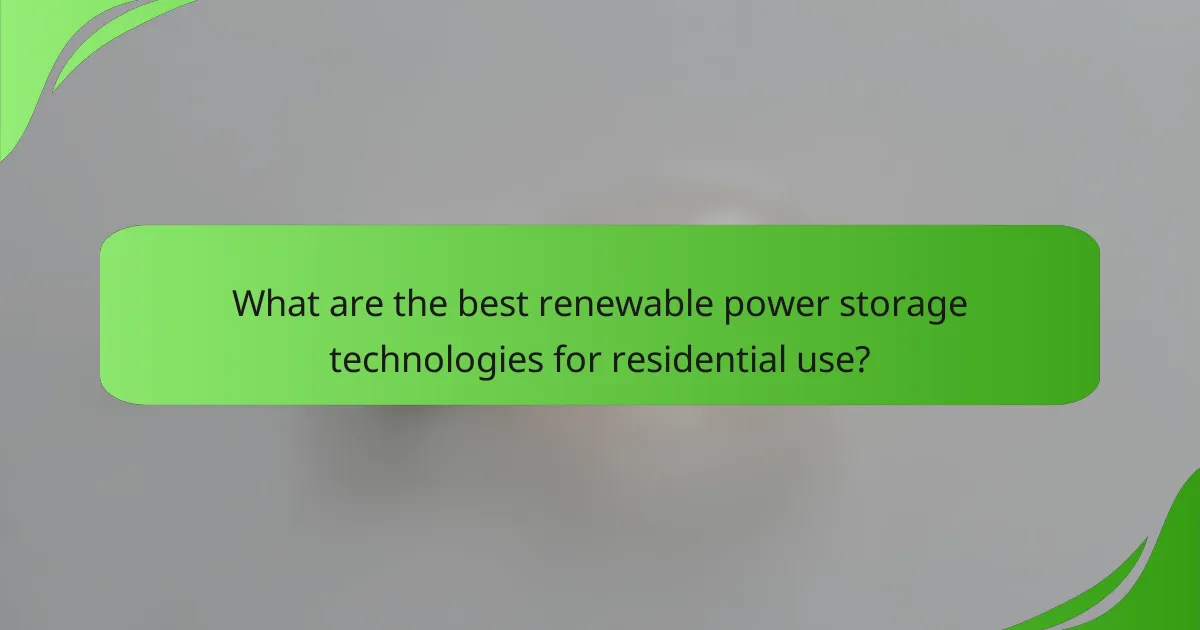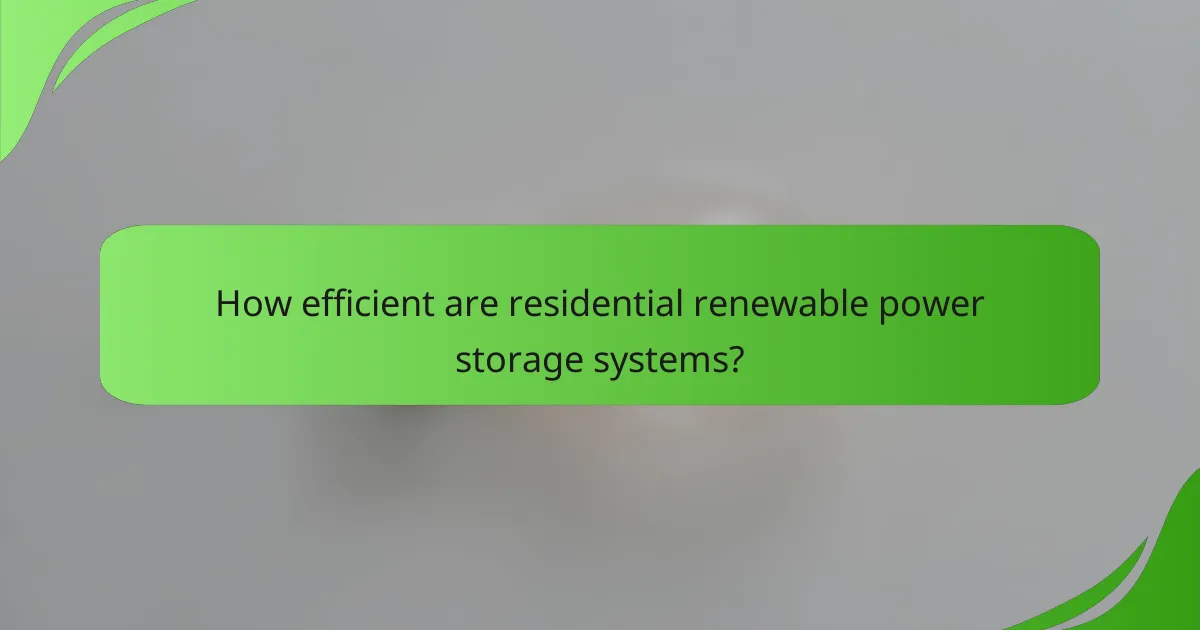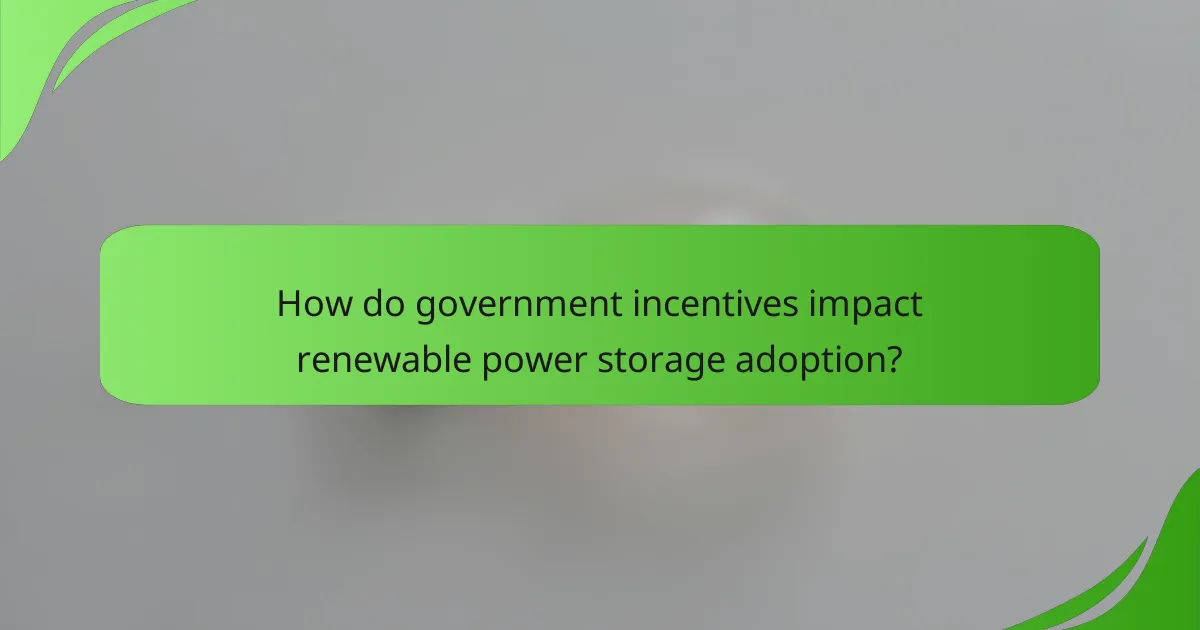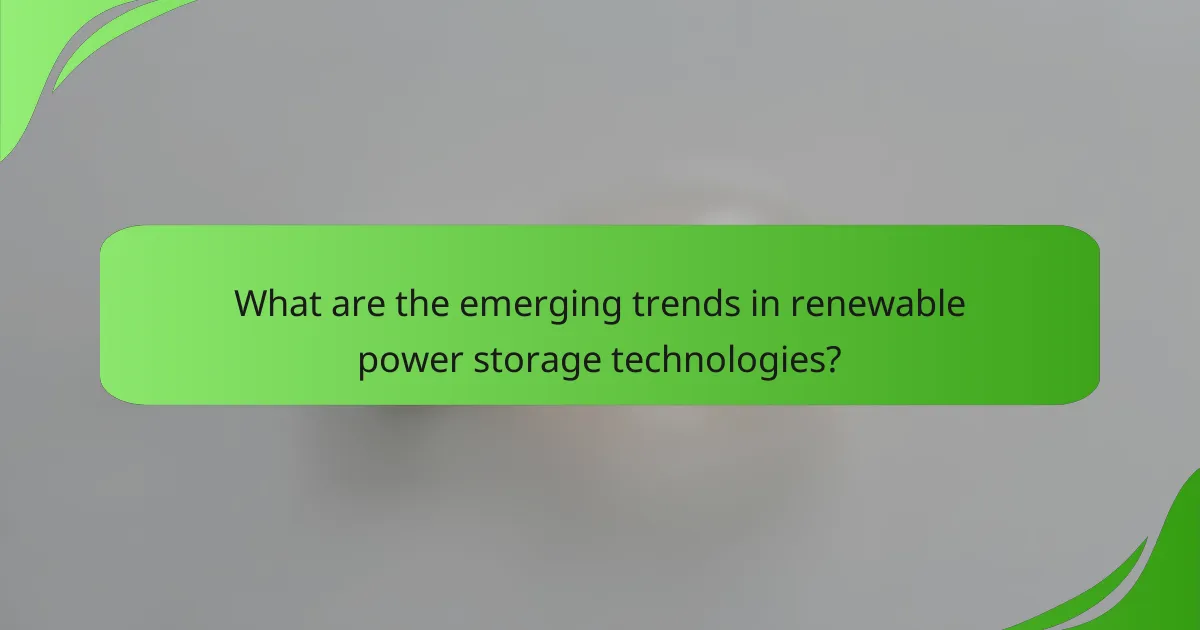Renewable power storage technologies are essential for optimizing residential energy use, with options such as lithium-ion, lead-acid, flow, saltwater batteries, and hydrogen storage systems available. Each technology offers distinct advantages in terms of efficiency, which can range from 70% to over 90%, and varying costs that homeowners must evaluate for both initial investment and long-term maintenance. Understanding these factors is crucial for making informed decisions about sustainable energy solutions for the home.

What are the best renewable power storage technologies for residential use?
The best renewable power storage technologies for residential use include lithium-ion batteries, lead-acid batteries, flow batteries, saltwater batteries, and hydrogen storage systems. Each technology has its own advantages and considerations regarding efficiency, cost, and suitability for different home energy needs.
Lithium-ion batteries
Lithium-ion batteries are the most widely used storage solution for residential renewable energy systems. They offer high energy density, efficiency rates above 90%, and a long lifespan of around 10-15 years. These batteries are ideal for homeowners looking to store solar energy for later use, especially during peak demand times.
However, the initial cost can be significant, often ranging from $5,000 to $15,000 depending on capacity and installation. Homeowners should consider the total cost of ownership, including potential rebates and incentives, to evaluate the long-term savings.
Lead-acid batteries
Lead-acid batteries are a traditional option for energy storage, known for their low upfront costs compared to lithium-ion alternatives. They are typically used in off-grid systems and can be effective for short-term energy storage needs. However, their efficiency is lower, around 70-80%, and they have a shorter lifespan of about 3-5 years.
While lead-acid batteries are cheaper initially, their frequent replacements and lower performance can lead to higher long-term costs. Homeowners should weigh these factors when considering lead-acid batteries for renewable energy storage.
Flow batteries
Flow batteries are a newer technology that allows for scalable energy storage, making them suitable for larger residential systems. They operate by circulating two electrolyte solutions through a cell, which can be easily scaled up by increasing the size of the tanks. This flexibility allows for longer discharge times and a lifespan of over 10 years.
However, flow batteries are still relatively expensive and less common in residential settings, with costs typically exceeding those of lithium-ion batteries. Homeowners interested in this technology should assess their specific energy needs and budget before investing.
Saltwater batteries
Saltwater batteries are an emerging technology that uses saltwater as the electrolyte, making them environmentally friendly and safe. They offer a longer lifespan and are less prone to overheating compared to lithium-ion batteries. Their efficiency is moderate, generally around 70-80%.
While saltwater batteries have lower upfront costs, their availability and performance in cold climates can be limiting factors. Homeowners should consider their local climate and energy requirements when evaluating this option.
Hydrogen storage systems
Hydrogen storage systems convert excess renewable energy into hydrogen gas, which can be stored and later converted back into electricity. This technology is particularly useful for long-term energy storage and can support larger energy demands. However, it is still in the developmental stage for residential use and can be costly to implement.
Homeowners interested in hydrogen storage should consider the infrastructure requirements and potential regulatory hurdles. While it offers promising advantages, the current high costs and complexity may not make it the best immediate choice for most residential applications.

How efficient are residential renewable power storage systems?
Residential renewable power storage systems vary in efficiency based on the technology used. Generally, efficiency rates can range from around 70% to over 90%, depending on the type of battery and its application.
Efficiency of lithium-ion batteries
Lithium-ion batteries are among the most efficient options for residential energy storage, typically achieving efficiencies between 90% and 95%. Their high energy density allows for more energy to be stored in a smaller footprint, making them ideal for home use.
However, factors such as temperature and charge cycles can impact their performance. Homeowners should consider investing in quality systems with good thermal management to maintain optimal efficiency.
Efficiency of lead-acid batteries
Lead-acid batteries generally have lower efficiency rates, typically ranging from 70% to 85%. While they are less expensive upfront, their shorter lifespan and lower energy density can lead to higher long-term costs.
These batteries are best suited for applications where cost is a primary concern and space is not limited. Regular maintenance is essential to maximize their efficiency and lifespan.
Efficiency of flow batteries
Flow batteries offer efficiencies in the range of 70% to 80%. They are particularly advantageous for larger-scale applications but are increasingly being adapted for residential use due to their scalability and long cycle life.
While they may not be as efficient as lithium-ion batteries, their ability to decouple power and energy storage makes them a flexible option. Homeowners should evaluate their specific energy needs and space availability when considering flow batteries.

What are the costs associated with renewable power storage technologies?
The costs of renewable power storage technologies vary significantly based on the type of system, installation, and ongoing maintenance. Homeowners should consider both initial investment and long-term expenses to determine the overall financial impact of these technologies.
Initial installation costs
Initial installation costs for renewable power storage systems can range from several thousand to tens of thousands of dollars, depending on the technology chosen. For instance, lithium-ion battery systems typically cost between $5,000 and $15,000 for residential setups, while other options like flow batteries may start higher due to their complexity.
Additionally, installation costs can be influenced by factors such as system size, local labor rates, and any necessary upgrades to existing electrical infrastructure. Homeowners should obtain multiple quotes to ensure they are getting a competitive price.
Maintenance costs
Maintenance costs for renewable power storage technologies are generally lower than for traditional energy systems. Most battery systems require minimal upkeep, with periodic checks on connections and performance. Annual maintenance can cost a few hundred dollars, depending on the system and service provider.
However, it’s crucial to consider warranty terms and potential replacement costs. Some batteries may need replacement after a certain number of cycles, which can add to long-term expenses. Understanding the lifespan and warranty of the chosen technology can help in budgeting for future costs.
Cost per kWh for different technologies
The cost per kilowatt-hour (kWh) for renewable power storage technologies varies by type. Lithium-ion batteries often have a cost of around $300 to $600 per kWh, making them a popular choice for residential use. In contrast, flow batteries can be more expensive, ranging from $500 to $1,000 per kWh, but they offer longer lifespans and greater scalability.
Homeowners should also consider the efficiency of each technology, as this impacts the overall cost-effectiveness. For example, while lithium-ion batteries are efficient, they may degrade faster than other options. Evaluating both upfront costs and efficiency will help in making an informed decision.

What factors should homeowners consider when choosing a storage solution?
Homeowners should evaluate their energy needs, available space, and local climate when selecting a storage solution for renewable power. These factors significantly influence the efficiency, cost, and overall effectiveness of the chosen system.
Energy needs assessment
Assessing energy needs involves calculating the total electricity consumption of your household, including peak usage times. Homeowners should consider both daily and seasonal variations in energy demand to determine the appropriate storage capacity.
A common approach is to review past utility bills to identify average usage, then estimate future needs based on lifestyle changes or additional appliances. This assessment helps in selecting a system that can adequately meet energy requirements without overspending on excess capacity.
Space availability
Space availability is crucial when choosing a storage solution, as different technologies require varying amounts of room. Homeowners should evaluate both indoor and outdoor spaces, considering factors like accessibility and ventilation.
For instance, battery systems can often be installed in garages or basements, while larger solutions like pumped hydro systems may need more extensive outdoor space. It’s essential to measure available areas and ensure compliance with local regulations regarding installation.
Local climate considerations
Local climate significantly impacts the efficiency and longevity of storage solutions. For example, extreme temperatures can affect battery performance, with some technologies performing poorly in very hot or cold conditions.
Homeowners should research how local weather patterns influence energy production and storage. In regions with frequent storms or prolonged cloudy periods, investing in a more robust storage system may be necessary to ensure a reliable energy supply.

How do government incentives impact renewable power storage adoption?
Government incentives significantly boost the adoption of renewable power storage by reducing initial costs and improving return on investment. These incentives can take various forms, such as tax credits, rebates, and favorable policies, making renewable energy systems more financially accessible for homeowners.
Tax credits for solar and storage
Tax credits for solar and storage systems allow homeowners to deduct a percentage of the installation costs from their federal taxes. In the U.S., the federal solar investment tax credit (ITC) offers a substantial deduction, which can cover a significant portion of the upfront expenses. This makes solar and storage installations more appealing, as the effective cost can drop considerably.
For example, if a solar and storage system costs $20,000 and the ITC is 26%, homeowners can reduce their tax liability by $5,200, effectively lowering their investment to $14,800. This financial incentive can lead to quicker payback periods and increased adoption rates.
State-specific rebate programs
Many states offer rebate programs that provide direct cash incentives for installing renewable energy systems, including storage solutions. These rebates can vary widely, with some states offering thousands of dollars to encourage adoption. For instance, California has robust programs that can cover a significant portion of installation costs.
Homeowners should research their state’s specific rebate offerings, as these can change frequently and may have eligibility requirements. Utilizing these programs can further reduce the financial burden and enhance the overall appeal of renewable power storage.
Impact of net metering policies
Net metering policies allow homeowners to receive credits for excess electricity generated by their solar systems, which can offset their energy costs. This practice not only incentivizes the installation of solar panels but also encourages the use of storage systems to maximize energy savings. By storing excess energy for later use, homeowners can benefit from both generation and consumption credits.
In states with favorable net metering policies, homeowners can see significant savings on their electricity bills, making the investment in renewable power storage even more attractive. However, it’s essential to understand the specific net metering rules in your state, as they can impact the overall financial viability of solar and storage systems.

What are the emerging trends in renewable power storage technologies?
Emerging trends in renewable power storage technologies focus on improving efficiency, reducing costs, and enhancing the lifespan of storage systems. Innovations in battery chemistry and integration with smart home systems are key developments that support residential energy independence and sustainability.
Advancements in battery technology
Recent advancements in battery technology are primarily driven by the need for more efficient energy storage solutions. Lithium-ion batteries remain the most popular choice for residential use due to their high energy density and decreasing costs, but alternatives like solid-state batteries are gaining attention for their potential safety and longevity benefits.
For homeowners, understanding battery capacity and discharge rates is crucial. Typical residential battery systems range from 5 kWh to 15 kWh, allowing for varying degrees of energy independence. Homeowners should consider their energy consumption patterns to choose a system that meets their needs without overspending.
When selecting a battery system, look for warranties that cover at least 10 years, as this indicates the manufacturer’s confidence in the product’s durability. Additionally, consider systems that offer modular designs, allowing for future expansion as energy needs grow or technology improves.
